Last Updated on 12th July 2024
Decoding Content Marketing: 50 Impactful Statistics and Insights
To navigate the complexities and nuances of content marketing, understanding key statistics is essential. When you’re looking to present the case to stakeholders for implementation of content marketing campaigns and strategies, providing supporting statistics with sources can be beneficial. With this in mind, we’ll explore 29 content marketing statistics, each accompanied by a concise summary and the respective source to make the case for content at the heart of any digital marketing or SEO strategy.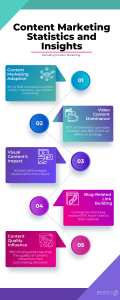
- Content Marketing Adoption: Statistic: 91% of B2B marketers and 86% of B2C marketers use content marketing. Summary: Content marketing is a ubiquitous strategy embraced by the majority of businesses, as indicated by the Content Marketing Institute’s “B2B Content Marketing 2022 Benchmarks, Budgets, and Trends” report.
- Content Marketing Industry Value: The content market industry revenue is set to reach 107 billion U.S. dollars by 2026 according to Statista.
- Video Content Dominance: Statistic: 87% of marketers use video content, and 83% find it an effective strategy. Summary: Video content has emerged as a dominant force in content marketing, according to the State of Video Marketing 2022 report by Wyzowl.
- Visual Content’s Impact: Statistic: Articles with images receive 94% more views. Summary: The inclusion of images significantly enhances content visibility, a finding supported by Jeff Bullas’ blog on content marketing.
- Blog-Related Link Building: Statistic: Companies that blog receive 97% more links to their website. Summary: Blogging is a powerful tool for link building, according to HubSpot’s “State of Inbound” report.
- Content Quality Influence: Statistic: 59% of consumers say that the quality of content influences their purchasing decisions. Summary: The quality of content plays a pivotal role in shaping consumer decisions, as highlighted by Adobe’s “State of Content” report.
- Long-Form Content Performance: Statistic: Content exceeding 3,000 words gets
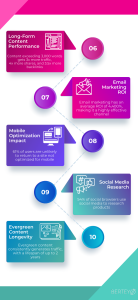 3x more traffic, 4x more shares, and 3.5x more backlinks. Summary: Long-form content tends to outperform shorter counterparts in terms of traffic, shares, and backlinks, according to a study by Backlinko.
3x more traffic, 4x more shares, and 3.5x more backlinks. Summary: Long-form content tends to outperform shorter counterparts in terms of traffic, shares, and backlinks, according to a study by Backlinko. - Email Marketing ROI: Statistic: Email marketing has an average ROI of 4,400%, making it a highly effective channel. Summary: The Return on Investment (ROI) for email marketing is exceptionally high, according to the Data & Marketing Association (DMA).
- Mobile Optimization Impact: Statistic: 61% of users are unlikely to return to a site not optimized for mobile. Summary: Mobile optimization is crucial for user retention, emphasizing the importance of mobile-friendly content, as reported by Google.
- Social Media Research: Statistic: 54% of social browsers use social media to research products. Summary: Social media platforms serve as significant channels for product research, according to GlobalWebIndex’s report on social media trends.
- Evergreen Content Longevity: Statistic: Evergreen content consistently generates traffic, with a lifespan of up to 2 years. Summary: Creating evergreen content provides enduring value, sustaining traffic over an extended period, according to the Content Marketing Institute.
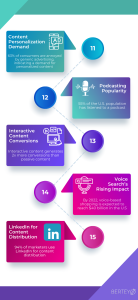
- Content Personalization Demand: Statistic: 63% of consumers are annoyed by generic advertising, indicating a demand for personalized content. Summary: Personalized content is essential to meet consumer expectations and avoid annoyance, based on research from OneSpot.
- Podcasting Popularity: Statistic: 55% of the U.S. population has listened to a podcast. Summary: Podcasting has achieved widespread popularity, capturing the attention of over half the U.S. population, according to Edison Research’s Infinite Dial study.
- Interactive Content Conversions: Statistic: Interactive content generates 2x more conversions than passive content. Summary: Encouraging user interaction enhances engagement and significantly boosts conversion rates, as indicated by a study from Demand Metric.
- Voice Search’s Rising Impact: Statistic: By 2022, voice-based shopping is expected to reach $40 billion in the U.S. Summary: The rise of voice search underscores the importance of optimizing content for voice-based interactions, according to OC&C Strategy Consultants.
- LinkedIn for Content Distribution: Statistic: 94% of marketers use LinkedIn for content distribution. Summary: LinkedIn is a dominant platform for content distribution, particularly in the B2B space, as reported by the Content Marketing Institute.
- Content Marketing Budget Allocation: Statistic: The average content marketing budget is 26% of the total marketing budget. Summary: Businesses allocate a substantial portion of their marketing
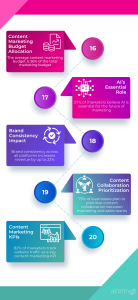 budget to content creation and promotion, based on a survey by the Content Marketing Institute.
budget to content creation and promotion, based on a survey by the Content Marketing Institute. - AI’s Essential Role: Statistic: 57% of marketers believe AI is essential for the future of marketing. Summary: The integration of artificial intelligence is considered crucial for the evolution of marketing strategies, according to Salesforce’s “State of Marketing” report.
- Brand Consistency Impact: Statistic: Brand consistency across all platforms increases revenue by up to 23%. Summary: Maintaining brand consistency directly correlates with increased revenue, highlighting its significance, as outlined by Lucidpress and Demand Metric’s “2018 Brand Consistency Report.”
- Content Collaboration Prioritization: Statistic: 73% of businesses plan to prioritize content collaboration between marketing and sales teams. Summary: Aligning marketing and sales teams for content collaboration is a priority for a majority of businesses, based on the “B2B Content Marketing 2022 Benchmarks, Budgets, and Trends” report by the Content Marketing Institute.
- Content Marketing KPIs: Statistic: 82% of marketers track website traffic as a key content marketing KPI. Summary: Website traffic remains a primary performance indicator for content marketing success, according to the Content Marketing Institute’s “B2B Content Marketing 2022 Benchmarks, Budgets, and Trends” report.
- Content Marketing Automation: Statistic: 63% of companies successful in content marketing use automation tools. Summary: Automation tools significantly contribute to the efficiency and success of content marketing efforts, based on the Content Marketing Institute’s “B2B Content Marketing
 2022 Benchmarks, Budgets, and Trends” report.
2022 Benchmarks, Budgets, and Trends” report. - Content Consumption Patterns: Statistic: 68% of consumers prefer content that educates them about a product or service. Summary: Educational content is highly valued by consumers during the decision-making process, according to the Content Marketing Association’s “Content Marketing in the UK 2019” report.
- Content Marketing Challenges: Statistic: 63% of businesses struggle with producing engaging content. Summary: Despite widespread adoption, creating compelling content remains a significant challenge for many businesses, as highlighted by the Content Marketing Institute’s “B2B Content Marketing 2022 Benchmarks, Budgets, and Trends” report.
- Content Repurposing Benefits: Statistic: Repurposing content can increase results by 75% without a proportional increase in investment. Summary: Repurposing content is a cost-effective strategy that significantly maximizes its impact and reach, as reported by Curata.
- Content Marketing ROI Measurement: Statistic: Only 21% of marketers are successful at tracking the ROI of their content marketing efforts. Summary: Measuring and attributing ROI to content marketing remains a challenge for the majority of marketers, based on the Content Marketing Institute’s “B2B Content Marketing 2022 Benchmarks, Budgets, and Trends” report.
- Visual Content Popularity: Statistic: 32% of marketers say visual images are the most imp
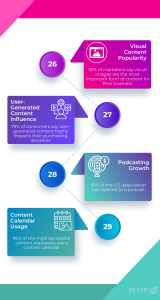 ortant form of content for their business. Summary: Visual content continues to dominate as a preferred and impactful content form, based on a survey by Social Media Examiner.
ortant form of content for their business. Summary: Visual content continues to dominate as a preferred and impactful content form, based on a survey by Social Media Examiner. - User-Generated Content Influence: Statistic: 79% of consumers say user-generated content highly impacts their purchasing decisions. Summary: User-generated content is a powerful tool for building trust and influencing consumer choices, as reported by Bazaarvoice.
- Podcasting Growth: Statistic: 55% of the U.S. population has listened to a podcast. Summary: Podcasting is a growing content avenue, reaching a broad audience, according to Edison Research’s Infinite Dial study.
- Content Calendar Usage: Statistic: 96% of the most successful content marketers use a content calendar. Summary: A structured content calendar is a common practice among successful marketers, aiding in planning and consistency, based on the Content Marketing Institute’s “B2B Content Marketing 2022 Benchmarks, Budgets, and Trends” report.
These 50 content marketing statistics provide valuable insights into the evolving landscape of digital marketing. From the importance of video and visual content to the challenges faced by businesses, these statistics offer a comprehensive view of the strategies and trends shaping content marketing. As businesses continue to adapt to the dynamic digital landscape, leveraging these insights can contribute to the development of effective and impactful content marketing strategies.


![Video Marketing Statistics [Updated for 2024] video](https://bertey.com/wp-content/uploads/2017/10/video-150x150.png)



